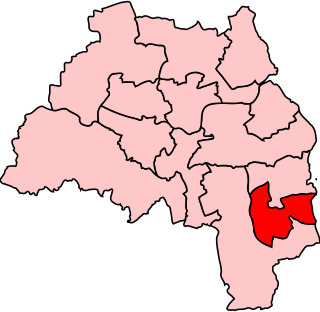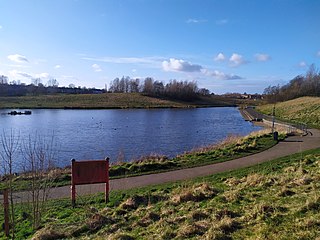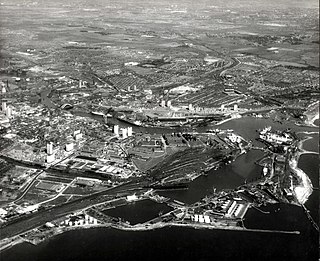
Bickley is a district and a local government electoral ward in South East London, within the London Borough of Bromley and the historic county of Kent. It is located 10.4 miles (16.7 km) south east of Charing Cross, bordering Elmstead to the north, Chislehurst to the north-east and east, Petts Wood to the south-east, Southborough to the south, Bromley to the south-west and west and Widmore to the north-west. It is known for its large and expensive houses.

Washington is a large town in the City of Sunderland local government district of Tyne and Wear, England, and historically part of County Durham. Washington is equidistant from the centres of Newcastle upon Tyne, Durham and Sunderland, with close ties to all three cities. It is the ancestral settlement of the Washington family, which George Washington descended from.

Sunderland is a port city and the administrative centre of the City of Sunderland metropolitan borough in Tyne and Wear, England. Sunderland is situated near the mouth of the River Wear which flows through the city and as well as the city of Durham, situated roughly 12 miles (19 km) south-west of Sunderland city centre. Sunderland is within the historic county of Durham.

The City of Sunderland is a metropolitan borough with city status in North East England. It is named after its largest settlement, Sunderland, but spans a far larger area, including nearby towns including Hetton-le-Hole and Houghton-le-Spring, as well as the surrounding suburban villages.

St James's is a central district in the City of Westminster, London, forming part of the West End. In the 17th century the area developed as a residential location for the British aristocracy, and around the 19th century was the focus of the development of gentlemen's clubs. Once part of the parish of St Martin in the Fields, much of it formed the parish of St James from 1685 to 1922. Since the Second World War the area has transitioned from residential to commercial use.

Roker is a tourist resort and affluent area of Sunderland, North East England, bounded on the south by the River Wear and Monkwearmouth, on the east by the North Sea, to the west by Fulwell and on the north by Seaburn. It is administered as part of the City of Sunderland and lies within historic County Durham.

Sunderland North was a borough constituency represented in the House of Commons of the Parliament of the United Kingdom. It elected one Member of Parliament (MP) by the first past the post system of election.

Sunderland South was, from 1950 until 2010, a constituency represented in the House of Commons of the Parliament of the United Kingdom. It elected one Member of Parliament (MP) by the first past the post system of election.

Silksworth is a suburb of the City of Sunderland, Tyne and Wear. The area can be distinguished into two parts, old Silksworth, the original village and township which has existed since the early middle ages, and New Silksworth, the industrial age colliery village which expanded north west of the original settlement. The former colliery being situated to the north west of the village near to the Gilley Law. The population of the ward was 10,931 at the 2011 census.

Hendon is an eastern area of Sunderland in Tyne and Wear, North East England, the location of much heavy industry and Victorian terraces and three high-rise residential tower blocks. The area is commonly referred to as the East End of Sunderland. Hendon is west of Sunderland Docks.

Farringdon is a suburb of Sunderland, Tyne and Wear, England. Originally a Monastic grange and manor estate for hundreds of years, Farringdon was rebuilt as a post-war council housing estate in the 1950s. It is approximately 3 mi (4.8 km) south of the city centre along the A690, close to Thorney Close, Silksworth, East Herrington, Gilley Law and Doxford Park. Electorally, the area comes under the St. Chad's ward of the City.

Sunderland Central is a constituency in the House of Commons of the UK Parliament. It is represented by the Labour Party MP Julie Elliott, who has held the seat since its creation in 2010.

William Doxford & Sons Ltd, often referred to simply as Doxford, was a British shipbuilding and marine engineering company.

Southwick is a former village and now a suburb on the north banks of the River Wear in the city of Sunderland in the county of Tyne and Wear, historically in County Durham. From 1894 to 1928, Southwick was administered by the Southwick-on-Wear Urban District Council, before being absorbed by Sunderland.

Sir William Theodore Doxford was a British shipbuilder and politician.

Bishopwearmouth Cemetery is a cemetery in Sunderland, Tyne and Wear, England. It lies between Hylton Road and Chester Road.

William Pile was a British shipbuilder. 'His genius was displayed in the building of ships, wherein he was not excelled. As Watt was great as a builder of engines; and Stephenson was great as a builder of railways; so William Pile was great as a builder of ships.'

Millfield is a suburb and electoral ward of the City of Sunderland, in Tyne and Wear, England. Most of the buildings in the area were built after the Victorian Era and are mostly built up of large terraced houses built for working-class people of the 20th century. When first built Millfield was located near the heart of Sunderland City Centre, but now has expanded. It now links Pallion with the City Centre.

The 1973 Tyne and Wear County Council election was held on 12 April 1973 as part of the first elections to the new local authorities established by the Local Government Act 1972 in England and Wales. 104 councillors were elected from 95 electoral divisions across the region's five boroughs. Each division returned either one or two county councillors each by First-past-the-post voting for a four-year term of office. The election took place ahead of the elections to the area's metropolitan borough councils, which followed on 10 May 1973.
The New Monkey was a nightclub in Sunderland, England, operating between 1999 and 2006. The club received wide notoriety in the North East of England, and became synonymous with Makina, a fast-paced hard style of techno music with live vocals.



















